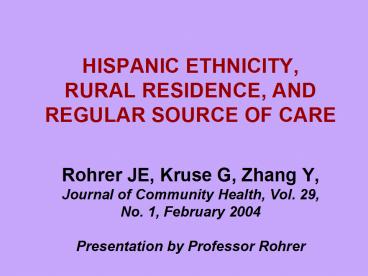HISPANIC ETHNICITY, RURAL RESIDENCE, AND REGULAR SOURCE OF CARE - PowerPoint PPT Presentation
Title:
HISPANIC ETHNICITY, RURAL RESIDENCE, AND REGULAR SOURCE OF CARE
Description:
About 30 % had other insurance plans. Just over 87 % owned their homes ... Having a usual source of care may be more important than insurance coverage. DISCUSSION ... – PowerPoint PPT presentation
Number of Views:13
Avg rating:3.0/5.0
Title: HISPANIC ETHNICITY, RURAL RESIDENCE, AND REGULAR SOURCE OF CARE
1
HISPANIC ETHNICITY, RURAL RESIDENCE, AND REGULAR
SOURCE OF CARE Rohrer JE, Kruse G, Zhang Y,
Journal of Community Health, Vol. 29,
No. 1, February 2004 Presentation by Professor
Rohrer
2
ABOUT DR. ROHRER
- Professor of health services research at Texas
Tech - Has published extensively in public health
- Author of a text on community health planning
published by APHA - Profiled as a pioneering author by Biomed
Central
3
BACKGROUND
- Having a usual source-of-care helps facilitate
use of medical care - The Behavioral Risk Factor Surveillance System,
the nations official survey for monitoring
population health asks about usual source-of-care
but not actual visits. - Usual source-of-care has eclipsed the number of
medical visits as a measure of access.
4
PURPOSE
- Identification of risk factors for not having a
usual source-of-care (USC) is a public health
responsibility because of its relevance to the
access problem. - Vulnerable populations such as residents of rural
areas and Hispanics may be at risk for not having
a USC - The purpose of the study reported here was to
test two hypotheses 1) that rural residence is
associated with reduced odds of having a USC and
2) that Hispanic ethnicity is associated with
reduced odds of having a USC
5
Overview
- TT5000 Survey
- Sample of 5,000 elders residing in West Texas
- Survey of health status, demographics, health
care accessibility and quality - Including satisfaction with access to
prescription drugs and specialists - Relatively large of Hispanics and rural
residents - Key personnel
- James E. Rohrer, P.I.
- Ty Borders, Barbara Rohland, Tom Xu,
co-investigators
6
TT5000 Methodology
- 65,000 household telephone listings
- 10 replications of 6,500 numbers
- Household screened for elderly person
- If more than 1, most recent birthday chosen
- Informed consent obtained
- MMSE used to screen for dementia
7
TT5000 Methodology, continued
- Participation rates
- Excluding eligible respondents who failed
cognitive screener 72 - Accounting for 361 telephones not answered 75
- Potential biases
- Hispanics and other races potentially slightly
under-represented - Females probably slightly over-represented
8
BETWEEN HISPANIC AND NON HISPANIC WHITE
- YOUNGER
- LESS EDUCATION
- MORE URBAN
- LESS CHD, HYPERTENSION, ARTHRITIS, STROKE, COPD
- MORE DIABETES
9
THE SAMPLE
- About 40 were between 65 and 70 years old and
slightly more than a quarter were between 71 and
74 years old. Less than one fifth were over 75
years of age. - About 70 were female.
- About 65 were non-Hispanic white
- Slightly more than 10 were Hispanic
- Slightly less than half were living in urban
counties
10
MORE DESCRIPTIVES
- Slightly more than 85 were on Medicare
- about 10 were on Medicaid
- About 30 had other insurance plans
- Just over 87 owned their homes
- income and educational levels were varied.
- About 50 were married.
11
MEDICAL SKEPTICISM
- One third believed that they could overcome most
illness without help from a medical professional - One third believed that home remedies were often
better than drugs. - Over 40 percent believed that their own behavior
determines the rate of recovery from illness. - Slightly more than half of the respondents
believed that they understood their health better
than doctors did.
12
USUAL SOURCE OF CARE
- PCT
PCT - YES
NO - Have a place to obtain
- medical services needed 94.32 5.68
- Have a personal doctor
- or nurse 86.96
13.04
13
ADJUSTED ODDS USUAL PLACE
- Ethnicity AOR CI
p - Hispanic 0.51 0.320.82
lt.01 - Other race 0.89 0.441.78
.73 - White non-Hisp ref
- Urban (vs rural) 0.85 0.631.16
.31
14
ADJUSTED ODDS OF HAVING PERSONAL MD OR NURSE
- AOR CI
p - Ethnicity
- Hispanic 0.63 0.450.88
lt.01 - Other race 0.69 0.441.08
0.10 - White not Hisp ref
- urban (vs rural) 0.91 0.741.13
0.40
15
DISCUSSION
- Either a regular MD or a usual place can
facilitate access to services. - The number of medical visits and the number of
clinical prevention services delivered are
greater when people have a regular source-of-care - Having a usual source of care may be more
important than insurance coverage
16
DISCUSSION
- Medical skeptics were less likely to have a usual
source of care - Financially disadvantaged people were less likely
to have a usual source of care
17
CONCLUSION
- Living in a rural county was not related to
having a usual source of care. - Hispanic seniors were less likely to have either
a usual source of care than non-Hispanic Whites. - Outreach efforts may be needed to establish and
foster usual-care relationships between Hispanic
seniors and clinics or other sources of care.































